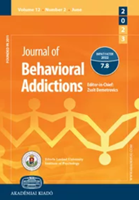Reduced loss aversion in value-based decision-making and edge-centric functional connectivity in patients with internet gaming disorder
Reduced loss aversion in value-based decision-making and edge-centric functional connectivity in patients with internet gaming disorder
Author(s): Wei Hong, Peipeng Liang, Yu Pan, Jia Jin, Lijuan Luo, Ying LI, Chen Jin, Wanwan Lü, Min Wang, Yan Liu, Hui Chen, Huixing Gou, Wei Wei, Zhanyu Ma, Ran Tao, Rujing Zha, Xiaochu ZhangSubject(s): Individual Psychology, Behaviorism, Substance abuse and addiction, Health and medicine and law
Published by: Akadémiai Kiadó
Keywords: loss aversion; value-based decision-making; Iowa gambling task; net score; edge-centric functional network; internet gaming disorder;
Summary/Abstract: Background and aims: Impaired value-based decision-making is a feature of substance and behavioral addictions. Loss aversion is a core of value-based decision-making and its alteration plays an important role in addiction. However, few studies explored it in internet gaming disorder patients (IGD). Methods: In this study, IGD patients (PIGD) and healthy controls (Con-PIGD) performed the Iowa gambling task (IGT), under functional magnetic resonance imaging (fMRI). We investigated group differences in loss aversion, brain functional networks of node-centric functional connectivity (nFC) and the overlapping community features of edge-centric functional connectivity (eFC) in IGT. Results: PIGD performed worse with lower average net score in IGT. The computational model results showed that PIGD significantly reduced loss aversion. There was no group difference in nFC. However, there were significant group differences in the overlapping community features of eFC1 . Furthermore, in Con-PIGD, loss aversion was positively correlated with the edge community profile similarity of the edge2 between left IFG and right hippocampus at right caudate. This relationship was suppressed by response consistency3 in PIGD. In addition, reduced loss aversion was negatively correlated with the promoted bottom-to-up neuromodulation from the right hippocampus to the left IFG in PIGD. Discussion and conclusions: The reduced loss aversion in value-based decision making and their related edge-centric functional connectivity support that the IGD showed the same value-based decision-making deficit as the substance use and other behavioral addictive disorders. These findings may have important significance for understanding the definition and mechanism of IGD in the future.
Journal: Journal of Behavioral Addictions
- Issue Year: 12/2023
- Issue No: 2
- Page Range: 458-470
- Page Count: 13
- Language: English

